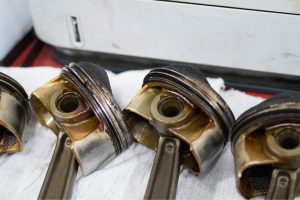
IPFS News Link • Transportation
Blue Haze
• Eric Peters AutosAll car engines burn oil.
That being the correct term, rather than "use" – which isn't.
It's an inevitability arising from the fact that they are designed to. Lubrication being necessary to keep the pistons from welding themselves to the walls of the engine's cylinders. If they fit like a dowel in a piece of furniture, you'd end up with what you get when you assemble a piece of furniture using dowels; i.e., something that (hopefully) doesn't move.
But you need the pistons to be able to move (up and down) within the cylinders, if you want the engine to run. If you want the car to move. So the pistons are just slightly smaller in diameter than the bore of the cylinders. Oil is there to prevent the two from becoming one.
It's only a very thin – microscopically so – layer of oil and the piston rings take up almost all of the remaining (and very small) gap between the piston's sides and the cylinder walls. But some oil remains on the walls and some of it is consumed when the spark plug fires the air-fuel mix inside the cylinder.



































